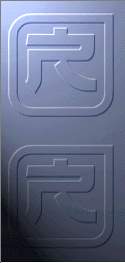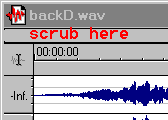
Zeug Records
Licks of the Trade
Did you know that...
 ...you
don't have to sequence notes stacatto all the time: why not mock the articulation
of a violin, trombone, or saw? To assist you in it, we offer a CAL (Cakewalk
Application Language) program called Slur
that converts a sequence of notes into one note
modulated by gradual pitch-bend messages.
Copy the file SLUR.CAL to the directory you have Cakewalk installed in.
Then all you have to do is select
a sequence on a track, press Ctrl-F1 (Tools|Run CAL),
and choose SLUR.CAL.
Note that the program assumes that your
synthesizer's pitch wheel span is set to 2 octaves (read
the instructions in the program code to see how to do it for the Sound Blaster
AWE32). This is, actually, how we in The R.A.F.
Golf Clubs recorded 'The Arctic Lullaby'.
...you
don't have to sequence notes stacatto all the time: why not mock the articulation
of a violin, trombone, or saw? To assist you in it, we offer a CAL (Cakewalk
Application Language) program called Slur
that converts a sequence of notes into one note
modulated by gradual pitch-bend messages.
Copy the file SLUR.CAL to the directory you have Cakewalk installed in.
Then all you have to do is select
a sequence on a track, press Ctrl-F1 (Tools|Run CAL),
and choose SLUR.CAL.
Note that the program assumes that your
synthesizer's pitch wheel span is set to 2 octaves (read
the instructions in the program code to see how to do it for the Sound Blaster
AWE32). This is, actually, how we in The R.A.F.
Golf Clubs recorded 'The Arctic Lullaby'.

 ...if you scrub the Overview (the thin strip above the Time Ruler) in a wave
window in Sound Forge 4.0 (our favourite sound editing tool), you'll hear
stuttering bits of your sound wave. That's what we call sample-scrubbing.
You can visually control where you scrub the sound form, thus playing harmonically
different parts (if so needed). To achieve a yet more technoish and computery
effect, go to Options|Preferences|Other dialog and set Loop Time
in the Audio Event Locator group to the minimum. Note that if you
stop sliding the mouse around, the wave file will play from the position
you stop for the time specified in the Loop Time parameter of the
same dialog, and then loop. Play with it and have fun!
...if you scrub the Overview (the thin strip above the Time Ruler) in a wave
window in Sound Forge 4.0 (our favourite sound editing tool), you'll hear
stuttering bits of your sound wave. That's what we call sample-scrubbing.
You can visually control where you scrub the sound form, thus playing harmonically
different parts (if so needed). To achieve a yet more technoish and computery
effect, go to Options|Preferences|Other dialog and set Loop Time
in the Audio Event Locator group to the minimum. Note that if you
stop sliding the mouse around, the wave file will play from the position
you stop for the time specified in the Loop Time parameter of the
same dialog, and then loop. Play with it and have fun!
 ...when you use the Pencil tool in the Piano Roll view
of Cakewalk 3+, the sequencer inserts notes that stick out
beyond measure. Like, a quarter note is 1:000, i.e 120 tick long,
not 119 ticks as it once was in old Cakewalk 2.
The difference is practically inaudible, but it actually makes your clips overlap.
Very annoying: when you drag a clip to a new place
between two other clips, the beginning of the succeeding one will be erased
(if your drag'n'drop options are set to Replace Old with New).
To help this, we offer the DuraFix progam.
It cuts one tick off notes of round length (multiple of 15 or 10).
Copy the file DURAFIX.CAL to the directory you have Cakewalk installed in.
Then all you have to do is select a bunch of notes you want to fix
(e.g., by touching a clip),
press Ctrl-F1 (Tools|Run CAL), and choose DuraFix.
...when you use the Pencil tool in the Piano Roll view
of Cakewalk 3+, the sequencer inserts notes that stick out
beyond measure. Like, a quarter note is 1:000, i.e 120 tick long,
not 119 ticks as it once was in old Cakewalk 2.
The difference is practically inaudible, but it actually makes your clips overlap.
Very annoying: when you drag a clip to a new place
between two other clips, the beginning of the succeeding one will be erased
(if your drag'n'drop options are set to Replace Old with New).
To help this, we offer the DuraFix progam.
It cuts one tick off notes of round length (multiple of 15 or 10).
Copy the file DURAFIX.CAL to the directory you have Cakewalk installed in.
Then all you have to do is select a bunch of notes you want to fix
(e.g., by touching a clip),
press Ctrl-F1 (Tools|Run CAL), and choose DuraFix.
 ...if
you strike a square bracket button on your keyboard, i.e. [ or ],
in Cakewalk,
it results in a big-step modification of the
value in the active edit-box or cell of the Track pane. That is, any value
is changed by 10, notes by the octave, musical times by the beat, and real-world
time by the second. Escpecially useful in the Key+ column of a track to throw riffs rapidly octave up or down
, as if swaying your playing hand all across the keyboard.
...if
you strike a square bracket button on your keyboard, i.e. [ or ],
in Cakewalk,
it results in a big-step modification of the
value in the active edit-box or cell of the Track pane. That is, any value
is changed by 10, notes by the octave, musical times by the beat, and real-world
time by the second. Escpecially useful in the Key+ column of a track to throw riffs rapidly octave up or down
, as if swaying your playing hand all across the keyboard.
 ...we gave a hand to customising the use
of SoundBlaster AWE32/64 with Cakewalk 6. With our AWE32 instrument definition
you can insert NRPNs by name and draw all the controllers the AWE supports.
Click this link for awe32ins.zip and
unzip the file AWE32.ins to your Cakewalk Program directory
(typically C:\Program Files\Cakewalk Pro Audio). In Cakewalk, open the dialog
Settings|Instruments and click Define. Then click Import and select
AWE32.ins. There's only one instrument defined in that file, and that is AWE32.
Now that you see AWE32 in the Instruments folder, close this dialog, select all the port/channel
combinations that use SB AWE32 Music Synth in the left pane, and select AWE32 in the right one.
Click OK and have fun.
...we gave a hand to customising the use
of SoundBlaster AWE32/64 with Cakewalk 6. With our AWE32 instrument definition
you can insert NRPNs by name and draw all the controllers the AWE supports.
Click this link for awe32ins.zip and
unzip the file AWE32.ins to your Cakewalk Program directory
(typically C:\Program Files\Cakewalk Pro Audio). In Cakewalk, open the dialog
Settings|Instruments and click Define. Then click Import and select
AWE32.ins. There's only one instrument defined in that file, and that is AWE32.
Now that you see AWE32 in the Instruments folder, close this dialog, select all the port/channel
combinations that use SB AWE32 Music Synth in the left pane, and select AWE32 in the right one.
Click OK and have fun.
For example, you may want to emulate a wah-wah pedal by changing the filtre cut-off frequency
while an instrument is playing. Just send a series of gradually (or rapidly) changing messages
of NRPN 16277 ranging 0..127 (100Hz..8,000Hz). You will not, of course, see the NRPN number
with our AWE32 instrument definition (Cakewalk will show the name "Filter Cut-off" instead).
If you have a SB AWE 32/64 installed,
you can click here to play FILTERSB.MID, a simple sample MIDI file
that uses this effect (NB: you have to have your SB Wave Synth as the default one to hear
the effect). Or you can check the MIDI file in your sequencer to see how this is done.
For more convenience, you can send one NRPN message to a channel and then simply
use Controller 38 (Data LSB) on the same channel
to control the filtre cut-off (easier to draw by hand).